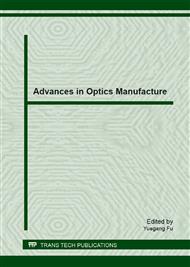p.523
p.529
p.536
p.542
p.548
p.554
p.560
p.567
p.575
Research on the Technology of Partial Masked Target Recognition
Abstract:
The result of target recognition is always influenced by the clutter background, low contrast and deficiency luminance of image. Besides the factors mentioned above, detection and recognition of partial masked target has the character of fragmented target, which leads to another problem. All the harmful factors cause that target recognition can not be realized by hybrid optoelectronic joint transform correlator (HOJTC) due to the weak correlation peaks, even no peaks appear. In this paper, input image of HOJTC is processed by the method of adaptive threshold, and power spectrum is processed by wavelet transform (WT) as well. The combination effectively controls the disturbance of noise and enhances the energy of diffractive light of target. Experiment of HOJTC shows that the method can enhance the contrast of correlation peaks of partial masked target and improve the detection and recognition capacity of HOJTC. As an example, the experiment results of fragmented airplane target before and after processing are shown in the paper, which demonstrate the effectiveness of the method.
Info:
Periodical:
Pages:
560-566
Citation:
Online since:
May 2013
Authors:
Price:
Сopyright:
© 2013 Trans Tech Publications Ltd. All Rights Reserved
Share:
Citation:


